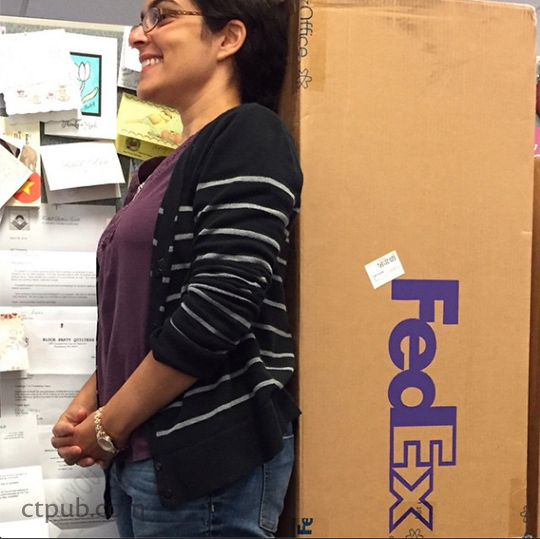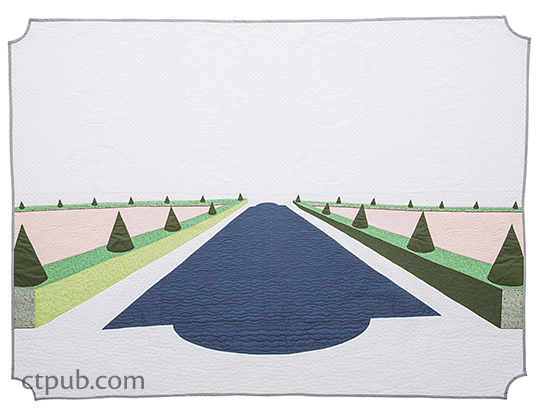Crafting a Book with Joanna: Modern Appliqué Illusions
Posted by Lynn Merrill on Nov 3rd 2014
Please welcome Production Editor Joanna, who is talking about her favorite project from Modern Appliqué Illusions, what her favorite part of her job is, and much more!
About working on a book team:
1. Please introduce yourself. What is your role on the book team and, in one sentence, tell us what you do?
I’m Joanna, and I’m one of three production editors at C&T. After the book’s content is fleshed out and checked for technical accuracy, I help review it for grammar, consistency, awkward spacing, and all those little nitpicky issues that make it look polished and easy to read when the finished book ends up in your hands.
2. What is one of the most challenging parts of your job?
Shipping. Seriously! Production editors coordinate the shipments of book subjects (i.e. the quilts and projects that need to be photographed at our studio). I’m 4´11˝. Some of the boxes we get are bigger than me. And don’t even get me started on that headache that is international shipping. (You need HOW many copies of that customs paperwork?

3. What is your favorite part about your job?
I love sample pages. This is when the designer showcases how she envisions the whole book will look by designing a few select chapters and projects. I’m always amazed at how these words I’ve been agonizing over since they were a Word document are so transformed by the beautiful InDesign treatment and photography.
4. Tell me about one of the weirdest book-related things that you’ve come across working at C&T.
It’s not one thing, per se, but I’ve learned a lot of odd things about the English language, such as there’s no male equivalent for “Thar she blows!” and no female equivalent of Jack of All Trades (the author had used “Jack-ess” but we couldn’t publish that for … reasons). We also don’t know what “exuding practicality” would look like, but it sure sounded uncomfortable. IKEA is an acronym, place mat is two words, and, according to Merriam Webster, there is more than one tooth fairy. Who knew?
5. Fill in the blank. “In a perfect world, all of the books I’m assigned to would …”
… thank their production team in the acknowledgments section. It’s a little thing, but it makes us feel loved. Usually the developmental editor and technical editor will get a nod, but those of us in production don’t. I like to joke that we’re a book’s unsung heroes! (For the record, Casey remembered to add us. I knew there was a reason she was so special!)
About Modern Appliqué Illusions:
1. What made this book stand out from the others?
Casey (Modern Appliqué Illusions) has a background in Art History, so it was fascinating to not just see quilts that use perspective, but also to learn about the history of using perspective in art. We at C&T fully know and appreciate that quilts are works of art, but rarely do we get to see the realms of fine art and fiber arts intersect so completely. It really made me look forward to editing her text and exploring the art concepts with her.
2. Did anything in the book process surprise you?
You know, not really. As a production editor, I’m assigned to 1/3 of all the books we publish a year, and I’ve been doing this awhile now. It takes quite a bit to surprise me! Plus, Casey was so organized that there wasn’t much weirdness (at least, not much production editor weirdness!)!
3. What’s one thing you’d like to tell prospective readers about Modern Appliqué Illusions?
These quilts are unlike anything I’ve ever seen in one of our books. They have this cool, Museum of Modern Art feel, and they’re definitely worth a look! I’m not a huge appliqué fan myself, but I might be tempted to try some of these.
4. What was your favorite project from the book? Why was it your favorite?
Grand Canal. I just love the feel of it. It makes me want to visit Europe or something.
5. Did Casey teach you anything that you didn’t know before working on her book?
Well, I don’t do much appliqué, so I suppose you can say she taught me how to do embroidery-edged appliqué. She definitely taught me a lot about art history and how to incorporate academic subjects you love into your quilting.
About the publishing industry:
1. How long have you worked in publishing?
I’ve worked as a writer and editor since I was a teen, but I’ve formally been in publishing for 2 years and 2 months.
2. What advice would you have for an aspiring author?
Be open to criticism. This can be one of the hardest things to learn, but it can also make your finished book so much better. We all need editors, even those of us with “editor” in our job descriptions. Remember that everyone on your book team wants you to succeed, and that we know it’s your baby. We still want it to feel like your vision … just the best possible version of it! Also, be ready for the long haul. Our average book takes at least a year, and we will be asking you questions throughout the whole process. But it’s definitely worth it.
3. How about an aspiring editor (or production coordinator, or designer)?
Love language. Love how it evolves to fit its different purposes. Love how you need to know the rules of grammar, structure, and clarity backward and forward so that you not only know how to break them, but also when to break them. Editing can be frustrating, and sometimes authors will make judgment calls you disagree with (hey, it happens …) but if you love language then the rest takes care of itself. Also, learn early on what kind of editing you like best. Contrary to what the average person might think, there are many types of editing (acquisitions, developmental, copy, production, proofreading, etc.) require very different mindsets.
4. Did you ever think you’d be working at a quilting publisher? Be honest!
I didn’t think so, but when I tell my old friends where I work, no one is surprised. I guess I always knew I’d be doing something with crafts and something with writing, so it was a natural progression.
5. What’s the coolest thing about working at C&T?
Sewing time, for sure! On Friday afternoons, it’s not uncommon to see the large conference room be turned into a sewing studio. It’s a nice little break that doubles as professional development. C&T’s annual fabric giveaway and the fact that we have a dog-friendly office so that I can bring my cocker spaniel to work are also top contenders for being the “coolest.”
Up next, Senior Production Coordinator Rue will be talking about her experience crafting a book!







